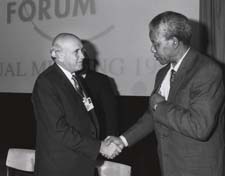

The Timeline highlights significant developments in the history of financial regulation against U.S. and world events. Choose a different decade below, or scroll down to discover more.

The Market Reform Act of 1990, addressing the October 1987 market break, authorized the U.S. Securities and Exchange Commission to take action in an emergency situation to maintain or restore fair and orderly markets and to ensure the prompt and accurate clearance and settlement of transactions.
Regulation S created a nonexclusive safe harbor from ’33 Act registration for offers and sales taking place outside of the United States. It was significantly amended in 1998.
Rule 144A provided a safe harbor from ’33 Act registration for the resale of certain securities sold only to “qualified institutional buyers.” The U.S. Securities and Exchange Commission also approved NASD’s PORTAL (Private Offering, Resale and Trading through Automated Linkages System), an electronic market on which pre-approved qualified institutions may trade securities qualifying under Rule 144A.
The Securities Enforcement Remedies and Penny Stock Reform Act authorized the U.S. Securities and Exchange Commission to seek monetary penalties in federal court against corporations and individuals violating provisions of the federal securities laws.
The fall of communist regimes in Eastern Europe created opportunities and challenges for financial and securities firms. The U.S. Securities and Exchange Commission responded with initiatives promoting the development of free capital markets, regulatory best practices and business access to capital.

The New York Stock Exchange introduced its first off-hours trading sessions.
Following issuance of SEC Rule 15c2-12 and of Municipal Securities Rulemaking Board Rule G-32 providing for the filing of official primary offering statements, the MSRB proposed the creation of the Municipal Securities Information Library (MSIL), which would house information deemed essential to the market. MSIL would collect, index, store electronically and make available via digital media official statements and advance refunding documents. Despite dissent from issuers fearing that the MSRB would use the opportunity to determine the content of such documents, and from private information vendors fearing that the MSRB would offer competing products, the U.S. Securities and Exchange Commission authorized the MSRB to implement MSIL in 1991.

The U.S. Securities and Exchange Commission revised its proxy policies to substantially increase the amount of information available to shareholders, giving more power to institutional investors and permitting shareholders to take active roles in supporting or opposing specific corporate decisions.

On August 30, Chairman Levitt announced the first major reorganization of the regional offices. The largest offices took on new titles: the Pacific (Los Angeles), Central (Denver), Midwest (Chicago), Northeast (New York), and Southeast (Atlanta) Regions. The Seattle regional office was shut down entirely, but all other regional or branch offices became district offices reporting to the regions, which, for the first time, reported directly to the Division of Enforcement.
After the U.S. Securities and Exchange Commission’s settlement with Salomon Brothers, Inc. for allegedly violating bidding rules to force up the price of U.S. Treasury bonds, state securities regulators charged that the firm’s state broker-dealer licenses should be cancelled. Salomon settled these charges by paying $2 million to the states and an additional $2 million to establish the Investor Protection Trust, a not-for-profit organization dedicated to investor protection and education.
During the 1980s, Prudential Securities sold $8 billion in limited partnership interests in oil and gas, real estate, and aircraft rental ventures, marketing them as low risk investments, akin to certificates of deposit, when in fact they were highly speculative. State and federal securities regulators collaborated on an investigation that led to civil and administrative actions, and the threat of criminal charges, resulting in a global settlement with both the federal government and the states.
U.S. Senator Joseph Lieberman (D-CT) introduced The Equity Expansion Act of 1993, which would have created a new class of stock option - the Performance Stock Option - and would have directed the U.S. Securities and Exchange Commission to overturn a Financial Accounting Standards Board proposal to change the current accounting treatment of stock options. Two years later, the FASB backed off its proposal to recognize expense for stock options; instead, it allowed current methods, supplemented by disclosure of the expense for recent option grants. In 2004, the FASB finally required public companies to report compensation cost based on grant-date fair value of the award.
State Street Global Advisors created an index fund which, rather than sold at net asset value at the end of the day, could be traded at current market price on an exchange. ETFs required exemption from the 1940 Act in order to function.

In its decision in Central Bank of Denver, N.S. v. First Interstate Bank of Denver, N.A., the U.S. Supreme Court found no liability for aiding and abetting a violation of Rule 10b-5 in a private action. Congress amended the ’34 Act the following year to confirm U.S. Securities and Exchange Commission authority to bring actions for aiding and abetting violations of the Act or any rule or regulation under the Act.
The Municipal Securities Rulemaking Board adopted Rule G-37 to prohibit brokers, dealers or municipal securities dealers from engaging in municipal securities business with an issuer within two years after a political contribution was made to an elected official of the municipal issuer by such broker or dealer or certain of its employees. The rule was intended to curb the practice of “pay to play,” whereby municipal securities business was acquired by making campaign contributions to state and municipal officials. In 1995, a federal court rejected the challenge of William Blount, Alabama bond dealer and chair of the Alabama Democratic Party, to the legality of Rule G-37.
Orange County, California announced that it had lost $1.5 billion from its investments in derivatives, causing the county to file for bankruptcy, the largest municipal bankruptcy to date. The county sued Merrill Lynch, the firm with which it had done the largest number of derivative trades. The Orange County debacle illustrated the growing use of complex derivatives and synthetic financial products by municipal governments and other institutional investors. Many of these products were unregulated. Orange County highlighted the importance of the “know your customer rule” for broker-dealers, even in connection with large investors.
The U.S. Securities and Exchange Commission amended Rule 15c2-12 to prohibit dealers from underwriting the securities of issuers, who do not agree in writing to provide the public with annual financial information and disclosure of certain materials events, to each of the approved, private Nationally Recognized Municipal Securities Information Repositories (NRMSIRs) and any state information depository in the state in which the issuer is located.
Two economists discovered that Nasdaq market makers seldom traded in odd-eighths, thus inflating margins. The Justice Department investigation found that Nasdaq market makers were colluding to keep the spread between bid and ask prices wide, harming retail investors.
The U.S. Securities and Exchange Commission approved rules proposed by the New York Stock Exchange, American Stock Exchange and NASD to establish a uniform voting standard, which prohibited companies listed on the NYSE, AMEX or NASDAQ from reducing or restricting voting rights of existing common stock shareholders.

On March 22, Chairman Levitt announced creation of the Office of Compliance, Inspections, and Examinations (OCIE) in order to bring more efficiency and “management focus” to the Commission’s examination program. All examination responsibilities were removed from the Divisions of Market Regulation and Investment Management and assigned to OCIE, which had oversight of regional office personnel.
The Private Securities Litigation Reform Act of 1995 (PSLRA) was passed by Congress over President Clinton’s veto. PSLRA was intended to curtail the securities plaintiffs’ bar from filing frivolous litigation and “strike suits,” lawsuits that cost less for the defendant to settle than defend.
The Municipal Securities Rulemaking Board implemented a Transaction Reporting System intended to provide price transparency to the municipal securities market. It posted limited transaction reports on The Bond Market Association website, and created a system of Nationally Recognized Municipal Securities Information Repositories (NRMSIRs) to collect and disseminate paper disclosure documents.
SEC Chairman Arthur Levitt authorized the formation of the Office of Municipal Securities, as part of the agency's commitment to improve regulation of the municipal securities market. The Office of Municipal Securities was an independent office until 2000, when it was put under the jurisdiction of the then-Division of Market Regulation.

Imposed as a result of the Nasdaq odd-eights scandal, these rules obliged market makers to post accurate prices of 100 heavily traded stocks on multiple venues, allowing investors to take advantage of competing quotes and encouraging the creation of new electronic communications networks (ECNs).
EDGAR (Electronic Data Gathering Analysis and Retrieval System) began as a model test program in 1984. EDGAR electronically performed automated collection and indexing of required U.S. Securities and Exchange Commission filings and accelerated the receipt and dissemination to the public of such filings. At first, EDGAR access was only through computer terminals located at various SEC offices or through paid proprietary databases. In 1994, a non-profit organization began to provide free Internet access to EDGAR; as funding ran low, the SEC took over this project. As of May 1996, all domestic public corporations were required to file SEC documents via EDGAR. In 2002, the SEC began to provide real time Web-based access to EDGAR.
The National Securities Market Improvement Act of 1996, in part, preempted state “Blue Sky” laws, an area in which the states had long regulated securities. The Act was intended to harmonize securities laws across the country and eliminate inconsistent state and federal law. It also ended state regulation of most mutual funds and excluded private investment companies from regulation, spurring the growth of hedge funds.
Rule G-38 was adopted to shed light on a practice that had grown since the adoption of Rule G-37 in 1993, which regulated “pay to play” practices. Rule G-38 applied to dealers contracting with consultants hired to solicit municipal securities business. In its original form, the rule required that the existence and financial terms of such contracts be disclosed to the Municipal Securities Rulemaking Board each quarter, as well as that any issuer contacted by such a consultant be informed of the consultant’s relationship with a dealer.
Lloyd’s of London recruited investors from the United States to join the exclusive ranks of its “Names.” However, for American investors, becoming a “Name” meant shouldering the insurance market’s mounting liabilities for asbestos lawsuits and natural disasters. The American investors’ agreements with Lloyd’s stipulated that any dispute regarding their investment would be resolved in a British court. State securities regulators conducted an investigation of the representations that Lloyd’s had made to investors in their jurisdictions in possible violation of state securities law. A $4.7 billion settlement put an end to these state actions by offering to cap the losses of investors and ending their obligations to Lloyd’s.
The NASD’s Rudman Report and the SEC’s 21(a) Report found that the NASD had been aware of Nasdaq’s anti-competitive practices in the odd-eighths scandal. The SEC sanctioned the NASD, and the NASD agreed to enhance its surveillance and audit systems. The NASD was divided into a holding company and two subsidiaries – the Nasdaq stock market and NASD Regulation Inc.
Mary Alice Brophy, director of compliance at Dain Bosworth in Minneapolis, became the first woman chair of the NASD Board of Governors. She had been appointed to the Board in 1993.
On October 15, after reviewing Regulation A applications covering small issues of stock for more than fifty years, the Regions turn “Reg A” filings over to a specialized unit within the Division of Corporation Finance.

In order to attract brokers to use its system, Island ECN developed the maker/taker pricing structure, which awarded a rebate to liquidity providers and imposed a fee on liquidity users.
In United States v. O’Hagan, an attorney, whose firm was representing a company about to acquire another company, bought the stock of the to-be-acquired company. He was charged with insider trading in violation of Rule 10b-5. The U.S. Supreme Court held that an insider trading violation could be based upon a “misappropriation theory.” An individual trading on information that had been appropriated in breach of a fiduciary duty or a confidential relationship was subject to liability, even if that information did not directly derive from company insiders and insiders received no benefit.
The U.S. Securities and Exchange Commission and the American Institute of Certified Public Accountants formed the Independence Standards Board (ISB) to bolster independence of auditors. The ISB had eight members, four from the certified public accounting profession and four representing the public interest. The ISB was intended to establish and maintain a body of standards of auditor independence for public entities. It ceased operation in 2001 after the SEC not only failed to support its conceptual framework, but also decided to issue its own revised auditor independence rules.

Long Term Capital Management, founded in 1994, was a successful and sophisticated hedge fund, with annual returns in the 30% range. LTCM primarily engaged in highly complex and leveraged derivative transactions with many of Wall Street’s investment banks. In spring 1998, the Asian markets experienced tremendous instability, resulting in the devaluation of their currency. In mid-August, Russia defaulted on its short-term ruble-denominated debt. Meanwhile, yields on U.S Treasury bonds fell significantly. LTCM began losing extraordinary amounts of money and appeared on the brink of bankruptcy. If LTCM defaulted, its counterparties, most of the major Wall Street investment firms, would have faced a serious liquidity crisis. The Federal Reserve Bank, fearing for the stability of the U.S. economy, assembled leading investment banks, LTCM’s clearing banks and LTCM’s major counterparties to infuse LTCM with substantial new capital, while putting significant constraints on its management in order to wind up the fund.
The Year 2000 problem involved how computer programs were processing and storing dates, with many programs utilizing only the last two digits (“00”) of a year. There was a fear that “2000” would be interpreted by computers as “1900,” creating havoc with critical systems across industries. In 1998, the U.S. Securities and Exchange Commission began to require public corporations and firms in the securities industry to update systems to prepare for Y2K and to disclose risks in connection with Y2K. Securities firms, government agencies, and private and public corporations spent billions preparing their computer systems for the dawn of the millennium.
The U.S. Securities and Exchange Commission required that plain English – such as short sentences, everyday language, active voice and no legal jargon - be used in prospectuses and filings, in an effort to make documents more readable and informative to the retail investor.
Electronic Communications Networks (ECNs), also known as Alternative Trading Systems (ATS), transformed how securities transactions were initiated and executed. Instinet, the first ECN, allowed subscribers, generally broker-dealers, to enter limit orders, which were then electronically matched with the opposite side of the trade. In 1998, the U.S. Securities and Exchange Commission adopted Regulation ATS, permitting most ECNs to decide whether to register as a broker-dealer or a national securities exchange. By defining "alternative trading systems," distinguishing them from registered exchanges, and imposing increased reporting requirements based on volume, Regulation Alternative Trading System prompted ECNs to begin merging and registering as exchanges.
The U.S. Securities and Exchange Commission proposed a package of ’33 Act regulatory reforms, popularly known as the “Aircraft Carrier” in light of its sweeping nature and the size of the proposed release (No. 33-7606). The Aircraft Carrier sank of its own weight but signaled some of the reforms adopted by the SEC in 2005.
A boiler room, in securities industry parlance, was an office space filled with cubicles and phone banks, where telemarketers repeated high-pressure sales pitches for investments that promised to deliver unrealistic returns. The North American Securities Administrators Association coordinated a nationwide enforcement effort, with an investor alert that explained boiler room scams to the public and offered practical advice on identifying and avoiding them.
At the urging of investor advocates and Congress, the U.S. Securities and Exchange Commission amended an earlier rule precipitated by hiring practices by the Cracker Barrel restaurant chain which put employment decisions outside of shareholder purview. The reversal gave shareholders increased opportunity to propose changes in corporate policies regarding employment and other social issues.
Congress enacted the Securities Litigation Uniform Standards Act (SLUSA) to prevent evasion of the 1995 Private Securities Litigation Reform Act (PSLRA). When PSLRA was enacted, most securities class actions were brought under federal law in federal court; after PSLRA, attorneys began bringing securities class action suits in state court. SLUSA required that large securities class actions be brought in federal court.
SEC Chairman Arthur Levitt Jr. raised concern about the manipulation of financial reporting through earnings management at a speech at New York University. He outlined a 10-point plan to enhance the integrity of corporate financial reporting and called for two panels to develop recommendations: the Blue Ribbon Committee on Improving the Effectiveness of Corporate Audit Committees (1998-1999) and the Panel on Audit Effectiveness (1998-2000) known as the O’Malley Panel after Shaun F. O’Malley, former Chairman of Price Waterhouse.

The Gramm-Leach-Bliley Act repealed the 1933 Glass-Steagall Act. Gramm-Leach-Bliley permitted direct subsidiaries of national banks to conduct securities activities, and bank holding companies to engage in merchant banking, insurance and real estate development. It also provided for U.S. Securities and Exchange Commission regulation of any securities business by banks, and imposed consumer protection laws relating to financial privacy.
On March 29th, the Dow Jones Industrial Average closed above 10000 for the first time.